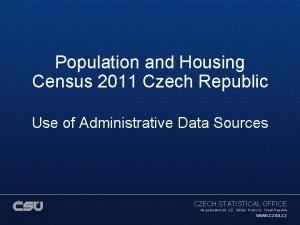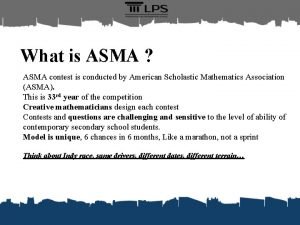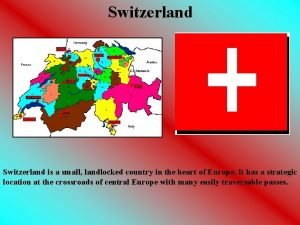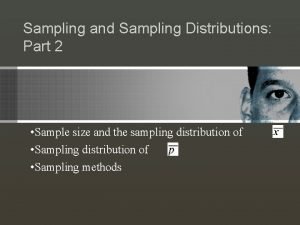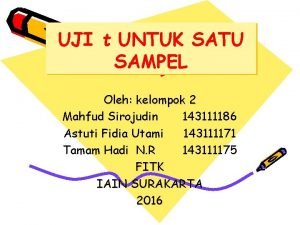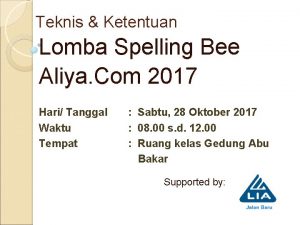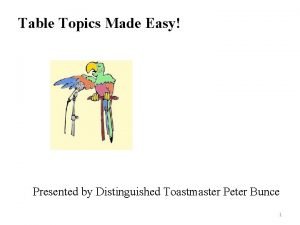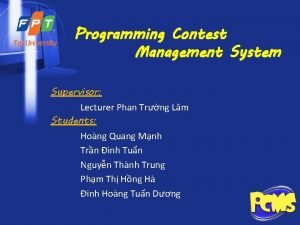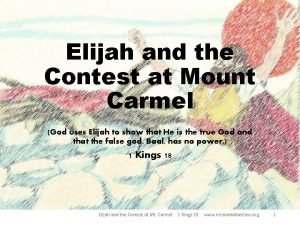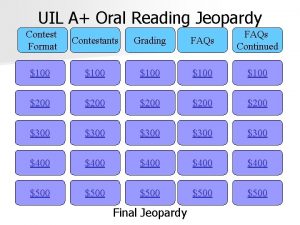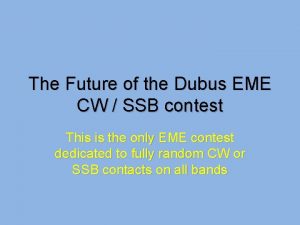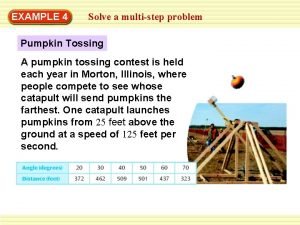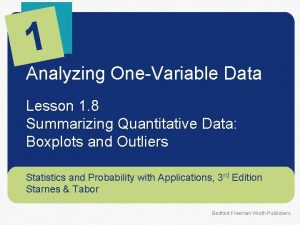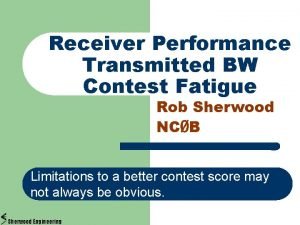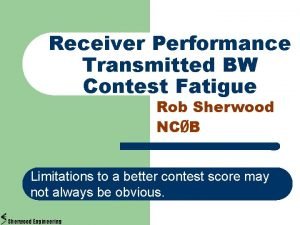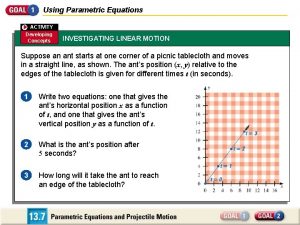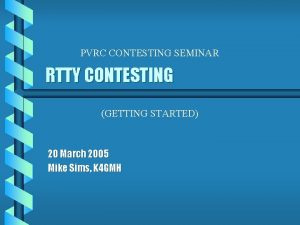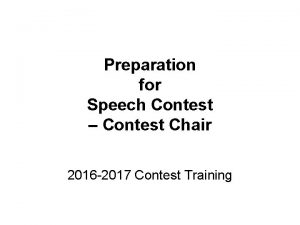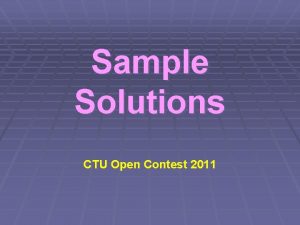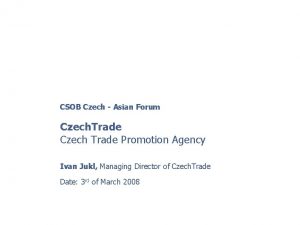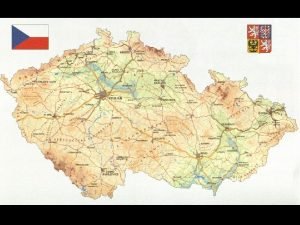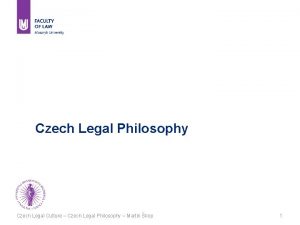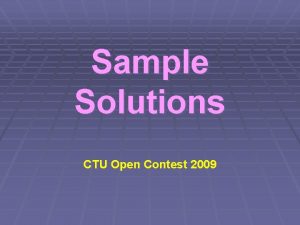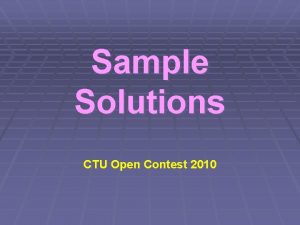Sample Solutions CENTRAL EUROPE REGIONAL CONTEST 2011 Czech





















































- Slides: 53

Sample Solutions CENTRAL EUROPE REGIONAL CONTEST 2011 Czech Technical University in Prague

PRACTICE: ANTS

Ants § Ants are “interchangeable” § => Meeting and “turning around” can be ignored § => Solution is trivial

PRACTICE: ELECTRICIAN

Electrician for (; ; ) { scanf("%d", &x); if (x == 0) break; printf((x == 2) ? "Bad luck!n“ : "Electrician needs 1 trips. n"); }

Sample Solutions § Cards § Vigenere § Unique § Trail § Program § Regulate § Analyse § Grille § Unchange § Execute

VIGENERE GRILLE

Vigenere Grille § Pretty easy, wasn’t it?

EXECUTE

Stack Machine Executor § Straightforward simulation § Beware of § Integer overflow (MUL)

PROGRAM

Stack Machine Programmer § The machine language is limited § Several ways to solve the problem § Polynomial § Linear combination of some values § Implement EQ § Implement IF/THEN

Polynomial way § 1 3, 2 10, 3 20 § Polynomial: A. x 2 + B. x + C § A. 12 + B. 1 + C = 3 § A. 22 + B. 2 + C = 10 § A. 32 + B. 3 + C = 20

“Equals” implementation § Sort inputs: 2 3 5 8 11 § Q = (((X mod 11) mod 8) div 5) § Q=1 iff X=5 § Q=0 otherwise § Q mul R (R – desired output for 5) § Sum for all inputs: § Q 1. R 1 + Q 2. R 2 + Q 3. R 3 + Q 4. R 4 + Q 5. R 5

ANALYSE

Vigenere Analyse § We try the cribs in all positions B A N K A C E W S Y B Q L U Y A V D C E

Vigenere Analyse § We try the cribs in all positions A B A N C E W S A D I Y B Q L V D C E K H U Y A

Vigenere Analyse § We try the cribs in all positions B A C A N K E W S U C J V G Y A Y B Q L A D I H V D C E

Vigenere Analyse § We try the cribs in all positions M O N E Y A C E W S N N Q R T U Y Y B Q L A D I H C V G J A V D C E

Analyse § All placements of the first crib § O(n. k) § All placements of the second crib § Test by hash map § O(n. k. H)

Analyse § Beware of § Key length and repetitions § ABCAB possible keys are ABC, ABCA § Overlapping words § There should be “two words” in the text § Sample input/output had an example

REGULATE

Strange Regulations § For each company, the cables form linear paths only § We keep the disjoint-set information § find § union § split

Regulate – Disjoint Sets

Regulate – Disjoint Sets

Strange Regulations § We need all operations quickly § Tree-based structures § Balancing!! § One query § O(log n) § O(sqrt(n)) – amortized (rebuild)

UNIQUE

Unique Encryption Keys § Trivial solution: O(n) for each query § Prepare a data structure § Perform the lookups faster

Unique – possible solution § One possibility: § Remember the “last previous” duplicity 2 6 12 5 6 4 7 6 7 14 2 14 0 1 2 3 4 5 6 7 8 9 10 11 X X 1 1 1 4 6 6 6 9

Unique Keys § Query is resolved in O(1) 2 6 12 5 6 4 7 6 7 14 2 14 0 1 2 3 4 5 6 7 8 9 10 11 X X 1 1 1 4 6 6 6 9 6≥ 3

Unique Keys § Query is resolved in O(1) OK 2 6 12 5 6 4 7 6 7 14 2 14 0 1 2 3 4 5 6 7 8 9 10 11 X X 1 1 1 4 6 6 6 9 1<2

Unique – time complexity § Lookup array prepared: O(n. log n) § Using a map § One query: O(1)

CARDS

Card Game § One game = permutation § Follow the position of all cards § Each card “travels” in some cycle § Periodically repeating occurrences

Card Game § Each card “travels” in some cycle § Periodically repeating occurrences 1 2 3 4 5 6 7 8 9 10

Card Game § When is the card “ 3” at position 6? § In the game #3 and then every 7 th game § 7. i + 3 1 2 3 4 5 6 7 8 9 10

Card Game § Track all of the cards at all positions § Card C is at the position P in the deck § FCP + i. CP. RCP § never

Card Game § All winning combinations (120 x N) § 1, 2, 3, 4, 5, x, x, x § 1, 2, 3, 5, 4, x, x, x § 1, 2, 4, 3, 5, x, x, x § 1, 2, 4, 5, 3, x, x, x § 1, 2, 5, 3, 4, x, x, x § … etc.

Card Game § For each winning combination § Do the cards ever occur at those places? When? § F 1 P + i 1 P. R 1 P § F 2 Q + i 2 Q. R 2 Q § F 3 S + i 3 S. R 3 S § F 4 T + i 4 T. R 4 T § F 5 U + i 5 U. R 5 U

Card Game § Find the common occurrence § Solving the Bezout’s identity A. i + B. j = C § Extended Euclidean algorithm § gcd(A, B) divisible by C

TRAIL

Racing Car Trail § What we cannot use: § Backtracking § Dynamic programming § What to use? § Graph theory

Trail – the graph § Each position is a node § Edge if the move is possible

Trail – key observation § We find the maximum matching

Trail – key observation § Maximum matching § Start from an unmatched node => lose

Trail – key observation § How to find answer to some node? § Find maximum matching without it § Try to find an augmenting path from it

Trail – key observation § Does the augmenting path exist? § YES => Alice can win § NO => Alice will lose

Trail – time complexity § Turn a matching (without one node) into another by 1 augmenting path § O(n 2) – the initial matching § O(n) for each node § TOTAL: O(n 2)

UNCHANGE

Unchanged Picture 1. Picture “normalization” § Join overlapping and continuing lines 2. Compare two pictures § § Try to map one line in Picture 1 to all lines in Picture 2 Check if it maps everything

Unchange – time complexity § Comparing lines – hashing § O(n^2. H) § O(n^3) is too much!

Unchange – faster solution § Find the “center of mass” X § Points in the longest distance from X map to each other § “Tie-breakers” § Not required in this contest (1000 lines max)

Authors Josef Cibulka Jakub Černý Zdeněk Dvořák Martin Kačer Jan Stoklasa Jan Katrenic Radek Pelánek
 Czech republic census 2011
Czech republic census 2011 Asma math problems
Asma math problems Oregon regional solutions
Oregon regional solutions Nctrca application
Nctrca application Consejo criminológico regional central
Consejo criminológico regional central Central highlands regional council tenders
Central highlands regional council tenders Chrlc
Chrlc Switzerland is landlocked country
Switzerland is landlocked country Merits and demerits of cluster sampling
Merits and demerits of cluster sampling What is the sample size in qualitative research?
What is the sample size in qualitative research? Volunteer sample vs convenience sample
Volunteer sample vs convenience sample Cluster random sampling
Cluster random sampling Cluster random sampling vs stratified
Cluster random sampling vs stratified Uji t satu sampel
Uji t satu sampel Next generation nclex sample item types
Next generation nclex sample item types Maryland young authors contest
Maryland young authors contest Yankee clipper contest club
Yankee clipper contest club Virginia tech high school programming contest
Virginia tech high school programming contest Virginia tech high school programming contest
Virginia tech high school programming contest Teknis lomba spelling bee
Teknis lomba spelling bee Table topics questions
Table topics questions Contest management system
Contest management system Hypo hatchet tree injector
Hypo hatchet tree injector Mt carmel contest
Mt carmel contest Anthem essay examples
Anthem essay examples Wiznet contest
Wiznet contest Tropical moscato art contest
Tropical moscato art contest Criteria for judging painting
Criteria for judging painting Yammer post examples
Yammer post examples Keynes beauty contest
Keynes beauty contest The contest among sellers to win customers is known as
The contest among sellers to win customers is known as Uil oral reading evaluation sheet
Uil oral reading evaluation sheet Dubus eme
Dubus eme Work sales contests
Work sales contests Objectives in making christmas lantern
Objectives in making christmas lantern Contest questions and answers
Contest questions and answers International filter photo contest
International filter photo contest The eurovision song contest on the 24th of may 1956
The eurovision song contest on the 24th of may 1956 Pumpkin tossing
Pumpkin tossing Naming contest rules
Naming contest rules The contest between businesses to win customers
The contest between businesses to win customers Icpc 2020 solutions
Icpc 2020 solutions Some students purchased pumpkins for a carving contest
Some students purchased pumpkins for a carving contest Yankee clipper contest club
Yankee clipper contest club Cq bw contest
Cq bw contest Cq bw contest
Cq bw contest Presentation error uva
Presentation error uva Mega man 9 box art
Mega man 9 box art In a pumpkin tossing contest in morton illinois
In a pumpkin tossing contest in morton illinois Rtty contest scene
Rtty contest scene Contest chair
Contest chair Egg drop challenge
Egg drop challenge National geographic photo contest 2018
National geographic photo contest 2018 Communication channels used in sales promotion
Communication channels used in sales promotion
